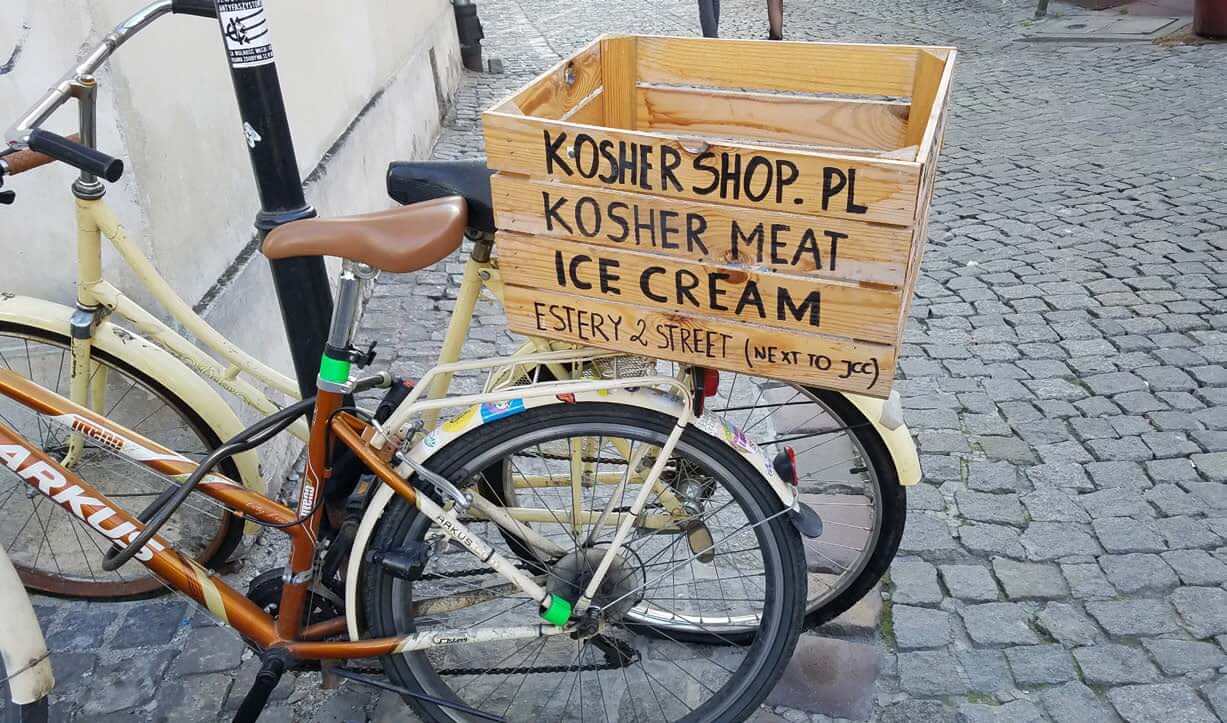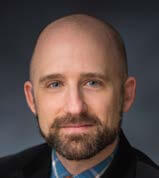Above: Ken Goldman. Jacob’s Ladder Triptych, 2015. Chromaluxe print after performance. Photos by Gideon Cohen
PEDAGOGY
I lower myself to the steps leading up to the brick barracks building. The concrete is hard but my feet are thankful for the relief. My group has just entered the building with the exhibits that display piles of eyeglasses, mountains of human hair. You know. That one. The bone-chilling one. I’ve decided not to go in with them. I told them, I’ve been through this building before quite a few times, just can’t do it again. They nod understandingly; they’re mensches, they get it. But I can’t help feeling that I’m abandoning them. When you’re a tour leader, the participants are your charges. They look to me for enlightenment, for wisdom. Now and then they look around to make sure that I’m with them. Maybe it’s a historical question about the whys and wherefores of a particular location, maybe it’s whether I know when we’re stopping for lunch or where the bathroom is. Either way, they need me. So yes, I’m much more than just a historian (“scholar-in-residence,” the brochure states proudly) on these Jewish heritage trips through east- central Europe, though I certainly am that—God knows I’m up till midnight some nights preparing my 7 a.m. lecture that bleary-eyed participants sit through as they sip gratefully on their coffee from the hotel buffet. I’m a guide, a confidante, a translator, sometimes mourner-in-chief, and even shaliaḥ ẓibur (prayer leader).

On the street in Kazimierz, the historic Jewish quarter of Kraków. Courtesy of the author
I do everything I can to make sure that this is not a Holocaust tour. Though in the end, it always is anyway.
Planning a tour itinerary in central and eastern Europe can sometimes seem like a bad Holocaust joke. 9 a.m., tour Auschwitz I; noon, lunch in the Auschwitz cafeteria (yes, there is such a thing and, believe it or not, the food’s not half bad); 2 p.m., memorial service next to the Birkenau gas chambers. But all ghastly humor aside, it’s not dissimilar from constructing a syllabus, though in this case one based not on chronology or theme but on geography. On the long travel day between Vilnius and Warsaw, can we squeeze in a tiny provincial museum on the Polish-Lithuanian border dedicated to maintaining the memory of the Jews who used to live in the region? From my perspective, we can’t afford to miss it. But if we stop to visit the museum, we’ll have to drop Treblinka from the itinerary. Someone might get upset about that omission (and, as it turns out, someone does). I’ll take the risk: this is part of the calculus I manage to empower folks to peer—if only for a moment—through the scrim that the Holocaust drapes over every single event that came before it to catch a glimpse of Jewish lives lived without the specter of destruction. In other words, I do everything I can to make sure that this is not a Holocaust tour. Though in the end, it always is anyway.
To that end, I arrange a lecture by a scholar friend of mine in Krakow who is an expert on Jewish life in Poland after World War II. Not surprisingly, some of the tour participants are more interested in whether the scholar herself is Jewish. After her talk, one man shakes her hand with great emotion for several long seconds, tears in his eyes, and tries to hand her a few high-value greenbacks. It’s an awkward, embarrassing moment, and one that throws into relief the multiple inequities in that interaction: an older, prosperous, male American financier, a tourist on vacation offering money to a younger, middle-class, female Polish scholar, a local. She is objectified as that rare and exotic item: an authentic, living Polish Jew. And, of course, this is Poland, so she must be hard up. It’s hard for American Jews—especially those raised during the Cold War, as most of the participants in my tours are—not to perceive eastern and central European Jews as “backward” in some way, frozen in time, a relic of a vanished civilization. And I must face my own perceptions of this narrative as well.
No wonder my tourists were more interested in my Krakow colleague herself than in the history she was relating.
And that’s why the meetings with real people are such a crucial part of the itineraries. Granted, as a historian, I might struggle for a bit if you pressed me to tell you whether the places or the people are more important for my tours. After all, there’s tremendous power in encountering historical events, people, and narratives not on the page but in situ, and to explain, like the tour guide in Amichai’s “Tourists,” that there, over the shoulder of that woman coming back from the market, that balcony is where Chaim Rumkowski, chairman of the Łódź Judenrat, gave his infamous “Give Me Your Children” speech. But what about that woman? Sometimes we have opportunities to meet with real, live people: the members of the Beit Warszawa Progressive synagogue who discovered their Jewish identity only in adulthood from a grandmother on her deathbed; the no-nonsense, chain-smoking woman who serves as president of the Vilnius Jewish community; the sweet, big-hearted non-Jewish Pole who, in his role as education director, welcomes us to Grodzka Gate – NN Theatre, a nonprofit that uses theater and interactive museum exhibits to educate the public about Lublin’s vanished Polish Jewish history. Interactions like those can be, and often are, the highlight of the day, for they bring to life abstractions—Poland, Jewish identity, the contemporary Jewish “revival”—that I can attempt to explain in my lectures but that only a living person can embody. No wonder my tourists were more interested in my Krakow colleague herself than in the history she was relating.
In Yehuda Amichai’s poem “Tourists,” redemption will come only when the guide tells his group that what’s not important is the Roman arch but rather the man who has bought fruit and vegetables for his family. As for me, I
am too much a historian to dismiss the arch. But I try to remember how important the people are. And not only the locals; my people, my tourists are just as important, as they wander through this foreign land, mouths agape, eyes wet with tears, seeking
some fragment of themselves.

Natan M. Meir is the Lorry I. Lokey Professor of Judaic Studies in the Harold Schnitzer Family Program in Judaic Studies at Portland State University. He is the author of Stepchildren of the Shtetl: The Destitute, Disabled, and Mad of Jewish Eastern Europe, 1800–1939 (Stanford University Press, 2020).